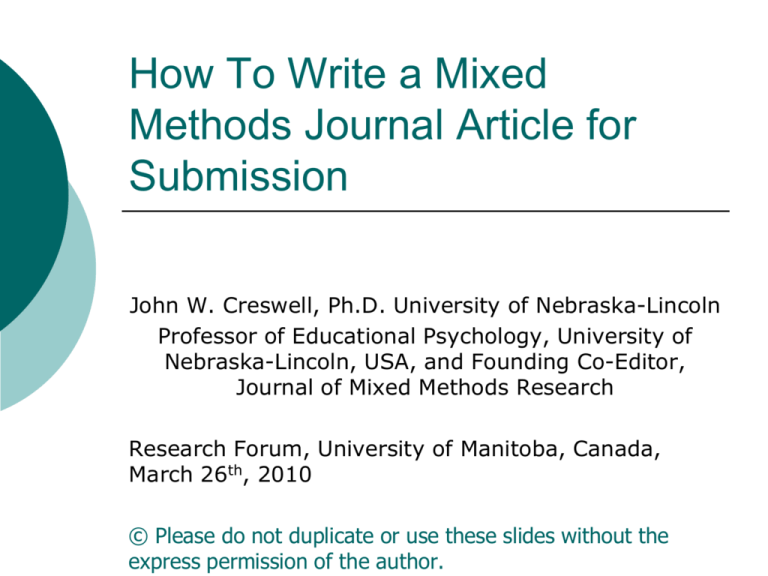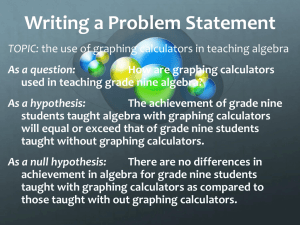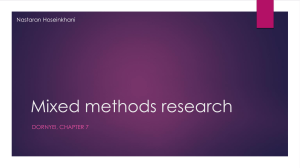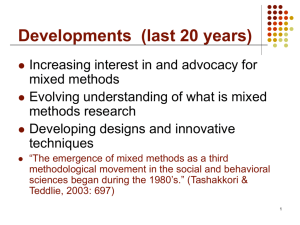How To Write a Mixed Methods Journal Article for Submission
advertisement

How To Write a Mixed Methods Journal Article for Submission John W. Creswell, Ph.D. University of Nebraska-Lincoln Professor of Educational Psychology, University of Nebraska-Lincoln, USA, and Founding Co-Editor, Journal of Mixed Methods Research Research Forum, University of Manitoba, Canada, March 26th, 2010 © Please do not duplicate or use these slides without the express permission of the author. Topics: Positioning myself Basics of mixed methods research Tips from a journal editor Basic ideas about writing a mixed methods journal article Review of two published mixed methods studies Positioning Myself View research as set of interactive components; not always linear Focus on rigorous data collection and analysis Work as an applied research methodologist Trained in quantitative research, embraced qualitative research, advocated for mixed methods Often consult with individuals in a step-by-step process 3 Basics of Mixed Methods Research Six core characteristics of mixed methods research The collection of both qualitative and quantitative data (open- and closed-ended) in response to research questions The analysis of both qualitative and quantitative data Persuasive and rigorous procedures for the qualitative and quantitative methods The integration of these two data sources (merging, connecting, embedding) The use of a specific mixed methods design that involves a concurrent or sequential integration (and equal or unequal emphases) An approach to research that has a philosophical foundation 5 When Should You Use Mixed Methods? • When the research problem merits this approach, such as, • when one data source • when a need exists to • when a need exists to • when a need exists to another is insufficient explain results explore first augment one database with 6 What are the Challenges to Conducting Mixed Methods Research? • • • • • Skills in both qualitative and quantitative research Openness to multiple methods Convincing others of the value of mixed methods Time/resources Familiarity with mixed methods 7 Tips from a Journal Editor Founding Editors: John W. Creswell and Abbas Tashakkori Current Editors: Max Bergman (Switzerland) and Donna Mertens (USA) Additional mixed methods journals… Field Methods Quality and Quantity International Journal of Multiple Research Approaches (on-line) Other journals that publish mixed methods studies (e.g., International Journal of Social Research Methodology) Special issue journals Types of articles published in JMMR Empirical articles – report of research studies in content areas (e.g., family medicine, communication studies, sociology, etc.) Methodological, theoretical articles – conceptual articles on timely topics in mixed methods that advance our knowledge of mixed methods research Book/software reviews Aspects of a good mixed methods empirical study Researchers collect both quantitative and qualitative data Both procedures are developed with rigor There is a linking – integration or connection – between the two types of data Researchers suggest implications for advancing the field of mixed methods research as well as the content field What criteria did I use as editor of JMMR I go to the “methods” section to see if quantitative and qualitative data are collected. I look in the “results” and “discussion” sections for some connection, merging, or embedding of one type of data in the other. I look in the “methods” discussion for rigorous quantitative and qualitative procedures. I look throughout the manuscript for how the author has positioned the study within the field of mixed methods research and how the study contributes a thoughtful, unique contribution to the mixed methods literature. I look in the “introduction” and throughout the manuscript for the paradigm stance of the author. I look at the “title” and the references to see if the author cites and is familiar with the mixed methods literature. I look in the “introduction” for the rationale for using mixed methods to study the research problem. Basic Ideas About Writing a Mixed Methods Journal Article Recommendations on writing and publishing mixed methods studies in the health sciences Stange KC, Crabtree BF, Miller W.L. Publishing multimethod research. Ann Fam Med. 2006; 4:292294. 1. Publish quan and qual papers in separate journals, but with clear references and links to the other article(s). 2. Publish concurrent or sequential quantitative and qualitative papers in the same journal. 3. Publish an integrated single article that describes both methods and findings and draws overarching lessons (with/w/o details in appendices) 4. Co-publish separate qualitative and quantitative papers accompanied by a third paper that draws overarching lessons from analyses across the two methods. 5. Develop an online discussion of readers and invited commentators to foster cross-disciplinary communities of knowledge. Basic guidelines for writing a mixed methods study Recognize that there is a structure to writing journal articles. Match the writing structure to the type of research design (e.g., mismatch - writing conclusions in concurrent style when design is sequential) Look at published mixed methods studies for models of writing Consider the following embedded elements from mixed methods in the writing of an article Elements of “good” mixed methods research to incorporate into a journal article (or proposal for funding) Title: Use words “mixed methods.” Also, create neutral title words that do not tip into qual or quan approach. Tip the words if the design calls for a strong priority for qual or quan. Abstract: Include information about the type of mixed methods design used. Statement of the Problem: Consider the reason for using mixed methods, and hint at this reason as a deficiency in past research. Write a good mixed methods purpose statement (study aims): Use script to write so that it includes a) general intent b) quan and qual purpose, data collection and analysis c) specific reason for mixing and how mixing occurred in the study. If you include research questions: State quan question (or hypotheses), qualitative question, and a mixed methods question. Elements of “good” mixed methods research to incorporate into a journal article (or proposal for funding) Mixed methods design: Identify the type of design used, draw a visual figure, define the design-type, give reasons for including the design (if not redundant with other information). Include references to recent mixed methods literature. Quan and Qual methods: Include detailed description of separate quan and qual methods to include: specific forms of quan and qual designs (e.g., correlational, grounded theory), recruitment procedures, sample selection, sample size, forms of data collection, topics related to data collection (e.g., validity, reliability of scores on instruments), types of data analysis Results: Report quan and qual results separately or concurrently. Make sure that results are consistent with the flow of the design and the priority given to the quan and qual sections. This section will be organized to reflect the type of design used in the study. Discussion: Report general quan and qual results for the study. Make sure that discussion mirrors the type of design in flow. Limitations: Among the limitations identify any challenges that arose during the mixed methods design. Future research: Talk about how the study adds to the mixed methods literature and opens up further lines for investigation. A Review of Two Mixed Methods Journal Articles A mixed methods study in the aging research field (Classen, Lopez, Winter, Awadzi, Ferree, Garvan (2007) A mixed methods study in the social sciences (Ivankova & Stick, 2007) ORIGINALRESEARCH Population-based health promotion perspective for older driver safety: Conceptual framework to intervention plan Sherrilene Classen Ellen DS Lopez Sandra Winter Kezia D Awadz Nita Ferree Cynthia W Garvan Abstract: The topic of motor vehicle crashes among the elderly is dynamic and multi-faceted requiring a comprehensive and synergistic approach to intervention planning. This approach must be based on the values of a given population as well as health statistics and asserted through community, organizational and policy strategies. An integrated summary of the predictors (quantitative research), and views (qualitative research) of the older drivers and their stakeholders, does not currently exist. This study provided an explicit socio-ecological view explaining the interrelation of possible causative factors, an integrated summary of these causative factors, and empirical guidelines for developing public health interventions to promote older driver safety. Using a mixed methods approach, we were able to compare and integrate main findings from a national crash dataset with perspectives of stakeholders. We identified: 11 multi-causal factors for safe elderly driving; the importance of the environmental factors - previously underrated in the literature- interacting with behavioral and health factors; and the interrelatedness among many socio-ecological factors. For the first time, to our knowledge, we conceptualized the fundamental elements of a multi-causal health promotion plan, with measurable intermediate and long-term outcomes. After completing the detailed plan we will test the effectiveness of this intervention on multiple levels. Keywords: safe elderly driving, mixed-method approach, public health model, intervention plan, health promotion Clinical Interventions in Aging 2007: 2(4) 677-693 20 CLASSEN ET AL. (2007) – FOCUS ON THE MIXED METHODS RESEARCH METHODS Overall study: good illustration of mixed methods Title: neutral Authors: skill set of team Theory: a priori, framework for data analysis Rationale for mixed methods: a more complete analysis Questions: quan and qual research questions Datasets – Quan FARS dataset; 6 Qual studies – separate data analysis Procedures: Concurrent data collection, separate analysis, priority (perhaps QUAN) Findings - integrating the two datasets around model; side by side comparison; additional findings beyond comparisons Methodological limitations – heterogeneous datasets Figure of procedures 21 STUDENTS’ PERSISTENCE IN A DISTRIBUTED DOCTORAL PROGRAM IN EDUCATIONAL LEADERSHIP IN HIGHER EDUCATION: A Mixed Methods Study Nataliya V. Ivankova*,† and Sheldon L. Stick** ......................................................................................................................................... ...................................................... The purpose of this mixed methods sequential explanatory study was to identify factors contributing to students’ persistence in the University of Nebraska-Lincoln Distributed Doctoral Program in Educational Leadership in Higher Education by obtaining quantitative results from surveying 278 current and former students and then following up with four purposefully selected typical respondents to explore those results in more depth. In the first, quantitative, phase, five external and internal to the program factors were found to be predictors to students’ persistence in the program: ‘‘program’’, ‘‘online learning environment’’, ‘‘student support services’’, ‘‘faculty’’, and ‘‘self-motivation’’. In the qualitative follow up multiple case study analysis four major themes emerged: (1) quality of academic experiences; (2) online learning environment; (3) support and assistance; and (4) student self-motivation. The quantitative and qualitative findings from the two phases of the study are discussed with reference to prior research. Implications and recommendations for policy makers are provided. ......................................................................................................................................... ...................................................... KEY WORDS: persistence; doctoral students; distributed program; online learning environment. INTRODUCTION Graduate education is a major part of American higher education, with more than 1850 million students enrolled in graduate programs (NCES, 2002). Approximately one fifth are graduate students pursuing doctoral *Assistant Professor, Department of Human Studies, University of Alabama at Birmingham, EB 202, 1530 3rd Ave S, Birmingham, AL, USA. **Professor, Department of Educational Administration, University of Nebraska-Lincoln, 123 Teachers College Hall, Lincoln, NE 68588-0360, USA. _Address correspondence to: Nataliya V. Ivankova, Department of Human Studies, University of Alabama at Birmingham, EB 202, 1530 3rd Ave S, Birmingham, AL 35294-1250, USA. E-mail: nivankov@uab.edu 93 0361-0365/07/0200-0093/0 _ 2006 Springer Science+Business Media, Inc. Research in Higher Education, Vol. 48, No. 1, February 2007 DOI: 10.1007/s11162-006-9025-4 22 An explanatory sequential design in a distance learning study This study reported an investigation of understanding students’ persistence in the Distance Learning Doctoral Program in Educational leadership in Higher Education (ELHE) offered by the University of Nebraska-Lincoln. The purpose was to identify factors contributing to students’ persistence in the ELHE Program. A quantitative Web-based survey of 278 current and former students was undertaken in the first phase. This survey measured predictors in the program related to program, adviser, faculty, institution, and student factors (based on a theoretical model). The dependent variable was status in the program organized into beginning students, matriculated students, graduated students, and inactive students. Following this initial quantitative phase, a second qualitative phase consisted of collecting data from four individuals, one representing each group, using multiple data sources to develop four case study profiles. Source: Ivankova, N. V.,& Stick, S. L. (2007). Students’ persistence in a distributed doctoral program in educational leadership in higher education: A mixed methods study. Research in Higher Education, 48, 93-136. Ivankova & Stick (2007) study: Overall study: good illustration of mixed methods – sequential design; 42 printed pages - long Title: neutral Authors: mixed methods specialist, quantitative specialist, doctoral dissertation Purpose statement: intent, first phase, second phase Theory: a priori, framework for data analysis Mixed methods design: type of design, rationale for design Figure of procedures: phases, procedures, product Datasets: Quan survey dataset; Qual case study design Point of interface: case selection Results and Discussion: Quan, then qual 24 Source: Ivankova and Stick (2007) How To Write a Mixed Methods Journal Article for Submission John W. Creswell, Ph.D. University of Nebraska-Lincoln Professor of Educational Psychology, University of Nebraska-Lincoln, USA, and Founding Co-Editor, Journal of Mixed Methods Research Research Forum, University of Manitoba, Canada, March 26th, 2010 © Please do not duplicate or use these slides without the express permission of the author.









